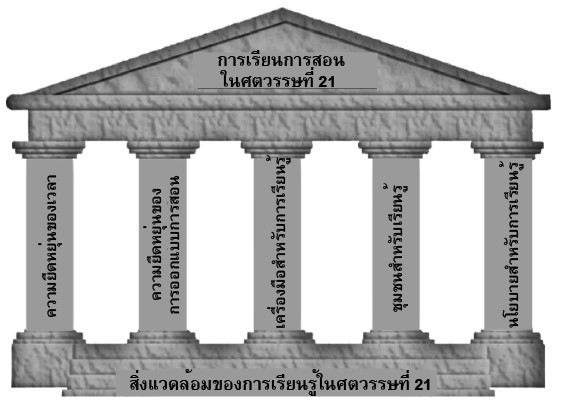การจัดการเรียนรู้วิทยาศาสตร์ในศตวรรษที่ 21
Main Article Content
Abstract
Somkiat Phornphisutthimas
รับบทความ: 15 กุมภาพันธ์ 2556; ยอมรับตีพิมพ์: 22 เมษายน 2556
บทคัดย่อ
การเรียนการสอนวิทยาศาสตร์ในปัจจุบันควรจัดการเรียนรู้โดยวิธีการที่หลากหลายเพื่อให้ผู้เรียนมีสมรรถนะสำคัญ คือ นำความรู้เดิมจากประสบการณ์เดิมที่มีอยู่มาสร้างความรู้ใหม่ในบริบทที่แตกต่างกันออกไป การเรียนการสอนเปลี่ยนแปลงจากการบรรยายเป็นการเรียนรู้ร่วมกันระหว่างผู้สอนและผู้เรียน ผู้สอนต้องประเมินผลการเรียนรู้ตามสภาพจริงเพื่อให้เข้าใจธรรมชาติการเรียนรู้ของผู้เรียนแต่ละคนและประเมินสมรรถนะที่ผู้เรียนกลุ่มสาระการเรียนรู้วิทยาศาสตร์ควรได้รับ การจัดการเรียนรู้วิทยาศาสตร์มีลักษณะเป็นการเรียนรู้ที่เน้นผู้เรียนเป็นสำคัญ โดยอาจใช้สื่อต่าง ๆ ประกอบและให้ลงมือทำปฏิบัติการจริงเพื่อสร้างทักษะต่าง ๆ สำหรับผู้เรียนและใช้เป็นเครื่องมือในการสืบเสาะและเรียนรู้ด้วยตนเองตลอดชีวิต
คำสำคัญ: การเรียนรู้ในศตวรรษที่ 21 สมรรถนะของผู้เรียน ทัศนคติในการเรียนรู้วิทยาศาสตร์
Abstract
Learning and teaching about sciences, nowadays, is managed by using various learning management to assist learners to have an important competency, using the prior experience to construct the new knowledge in different contexts. The learning and teaching method has been changed from lecture to collaboration between teachers and learners. The teachers have authentically assessed to recognise the learners’ learning and evaluate their achieved competencies in learning sciences. The learning management in science is the child-oriented learning by using various media and hands-on practicals to construct learners’ skills, as well as used to be tools for inquiry and lifelong learning.
Keywords: 21st Century skill, Students’ competency, Attitude towards science learning
Downloads
Article Details

This work is licensed under a Creative Commons Attribution-NonCommercial 4.0 International License.
References
กระทรวงศึกษาธิการ. (2551ก). หลักสูตรแกนกลางการศึกษาขั้นพื้นฐาน พุทธศักราช 2551. กรุงเทพฯ: สำนักวิชาการและมาตรฐานการศึกษา สำนักงานคณะกรรมการการศึกษาขั้นพื้นฐาน กระทรวงศึกษาธิการ.
กระทรวงศึกษาธิการ. (2551ข). ตัวชี้วัดและสาระการเรียนรู้แกนกลาง กลุ่มสาระการเรียนรู้วิทยาศาสตร์ ตามหลักสูตรแกนกลางการศึกษาขั้นพื้นฐาน พุทธศักราช 2551. กรุงเทพฯ: สำนักวิชาการและมาตรฐานการศึกษา สำนักงานคณะกรรมการการศึกษาขั้นพื้นฐาน กระทรวงศึกษาธิการ.
พระราชบัญญัติการศึกษาแห่งชาติ พ.ศ. 2542 แก้ไขเพิ่มเติม (ฉบับที่ 2) พ.ศ. 2545 และ (ฉบับที่ 3) พ.ศ. 2553. จาก http://media.wix.com/ugd/2cef27_c7c9894bd 94e7b6e42e48f128de37069.pdf สืบค้นเมื่อวันที่ 21 เมษายน 2556.
สมเกียรติ พรพิสุทธิมาศ กุลชา ลี้ไพโรจน์กุล สุรศักดิ์ ละลอกน้ำ สุภาภรณ์ ศิริโสภนา สายสุณีย์ ลิ้มชูวงศ์ วัฒนีย์ โรจนสัมฤทธิ์ และธรรมศักดิ์ รินทะ. (2551, พฤศจิกายน). ผลกระทบของการเรียนรู้โดยใช้สมองเป็นฐานต่อพฤติกรรมการเรียนและผลสัมฤทธิ์ทางการเรียนรายวิชาชีววิทยาในระดับชั้นมัธยมศึกษาตอนปลาย. การสัมมนาวิทยาศาสตร์ศึกษาแห่งชาติ ครั้งที่ 3. โรงแรมโลตัสปางสวนแก้ว เชียงใหม่.
สมเกียรติ พรพิสุทธิมาศ. (2551). การสอนวิทยาศาสตร์โดยเน้นทักษะกระบวนการ. ก้าวทันโลกวิทยาศาสตร์ 8(2): 28-38.
Abram, S. (2013). The Learning Pyramid. Retrieved from http://stephenslighthouse.com/2010/02/26/the-learning-pyramid/, 21 April 2013.
Cerini, B., Murray, I., and Reiss, M. (2003). Student Review of the Science Curriculum. London: http://www.planet-science.com/sciteach/review/ Findings.pdf.
Fansher, H. (2011). 21st Century Learning Environments: Building a Better School. Canada: Springbank Community High School.
Hofstein, A., and Lunetta, V. N. (2004). The laboratory in science education: Foundations for the twenty-first century. Science Education 88(1): 28-54.
James, M., Black, P., Carmichael, P., Conner, C., Dudley, P., Fox, A., et al. (2006). Learning How to Learn: Tools for Schools. New York: Routledge.
Jenkins, E., and Nelson, N. W. (2005). Important but not for me: Students’ attitudes toward secondary science. Research in Science and Technology Education 23(1): 41-57.
Laloknam, S., Sirisopana, S., and Phornphisutthimas, S. (2010). Learning Retention in Undergraduate Biology using A Hands-on Practical “Enzyme Detection from Vegetables and Fruits”. Journal of Chemistry and Chemical Engineering 4(5): 29-35.
Laurillard, D. (2012). Teaching as a Design Science: Building Pedagogical for Learning and Technology. New York: Routledge.
Linn, M. C., and Eylon, B.-S. (2011). Science Learning and Instruction: Taking Advantage of Technology to Promote Knowledge Integration. New York: Routledge.
Murray, I., and Reiss, M. (2005). Student Review of the Science Curriculum. School Science Review 87(318): 83-93.
National Academies Press (NAP). (2000). How People Learn: Brain, Mind, Experience, and School. Washington, DC: Author.
National Academies Press (NAP). (2005). How Students Learn: History, Mathematics, and Science in the Classroom. Washington, DC: Author.
Novak, D., and Gowin, D. B. (2002). Learning How to Learn. USA: Cambridge University.
Ogunkola, B. J., and Samuel, D. (2011). Science teachers’ and students’ perceived difficult topics in the integrated science curriculum of lower secondary schools in Barbados. World Journal of Education 1(2): 17-29.
Osborne, J., and Collins, S. (2001). Pupils’ views of the role and value of the science curriculum: A focus group study. International Journal of Science Education 23(5): 441-467.
Phornphisutthimas, S., Panijpan, B., Wood, E. J., and Booth, A. G. (2007a). Improving Thai student’s understanding of concepts in protein purification by using Thai and English versions of a simulation program. Biochemistry and Molecular Biology Education 35(5): 316-320.
Phornphisutthimas, S., Thamchaipenet, A., and Panijpan, B. (2007b). Conjugation in Escherichia coli: A laboratory exercise. Biochemistry and Molecular Biology Education 35(6): 440-445.
Toplis, R., ed. (2011). How Science Works: Exploring Effect Pedagogy and Practice. New York: Routledge.
Wagner, T. (2008). The Global Achievement Gap: When Even Our Best Schools Don’t Teach the New Survival Skills Our Children Need – and What We Can Do about It. New York: Basic Books.
Wiggins, G. P., and McTighe, J. (2005). Understanding by Design. 2nd ed. Alexandria, VA: ASCD.
Wiggins, G. P., and McTighe, J. (2011). Understanding by Design Guide to Creating High-Quality Units. Alexandria, VA: ASCD.
Williams, J. D. (2008). Science Now and then: discovering how science works. Science School Review 90 (330): 45-46.
